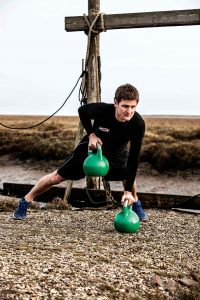Push-up tekkers with Mark Laws
Share
Mark Laws takes five minutes away from his Facebook feed to help you perfect your push-up tekkers…

Over the last few months my social media timeline has been awash with people doing 22 push ups in support of PTSD within the military fraternity. Anything that raises awareness and/or money to help such a good cause is always a good thing. But my brain never switches off and I cannot help but notice that almost every set of push ups I have seen could have been done more efficiently.
The problem stems from the elbow position.
Before I go into more detail let me share an important piece of advice with you – I was once told that I need to be able to answer the question ‘why?’ five times before doing anything. If you cannot answer that question five times, then you do not have valid enough reasons to be doing the task.
That might sound harsh, but when you just perform certain exercises for the sake of it then the likelihood of enhancing your performance is severely limited.
So, when watching anyone perform a push up you will notice that 99% of the time the elbows will flare out to the sides – as ‘normal’ as that seems it is actually dramatically reducing your performance levels.
Here are 5 tips to help improve your push up efficiency…
1 Safety for the shoulder: If you stand upright with your arms down by your side, bend 90 degrees at the elbow like a thunderbird, then lift your arm up until the elbow is level with the shoulder…your arms will then be in a typical push up position. The shoulder is EXTERNALLY rotated away from the body in this position. The shoulder is also in a very vulnerable position where it is much more likely to get injured. Alternatively, if you stand upright and hold your hands directly in front of your shoulder with the palms facing the floor then pull your elbows in towards your ribs. The shoulder is now INTERNALLY rotated towards the body. This is a much safer position for the shoulder. Now try this facing the floor…
2 Structural integrity: The most common regression for the push up is to perform it on your knees. This is an absolute no-no. The whole point of any exercise should be to make us stronger and/or to make our lives easier to live. So as we spend our time moving around on our feet and lifting/carrying/moving items with our hands it is vital that we have ‘structural integrity’ from our ankles to our earlobes, this ensures that our body is capable of communicating properly and working as one – which is how we need it to work on a daily basis. Therefore, a push up should always be performed on the toes – if you aren’t strong enough then elevate the hands onto a higher surface…just make sure you have that straight line from the ankle through to the shoulder.
3 Increased ROM: Range of Movement is our friend, but the fact we spend most of our lives sitting at desks and fiddling with our gadgets means that our bodies don’t have anywhere near the ROM that they should and could have. When performing a push up with the shoulders externally rotated then you will only ever get around 50% of the ROM at the elbow. However, with the shoulders internally rotated the ROM will be greatly increased. This will help with all athletic movements and will ensure your elbows have a much better chance of living happily ever after.
4 Increased torque: This can best be described as a rotational force. When internally rotated much more torque can be transferred from the shoulder through to the hand – this will mean more strength and power throughout the movement and your efficiency will go through the roof.
5 Focus on triceps: Most people train for aesthetic reasons, so of course it is very important to develop large pec/chest muscles. However, from a performance point of view this is not very helpful. On a positive note, the triceps are much more useful for any throwing/pushing/pressing movement…and in our new internally rotated push up position we can be sure to focus on our triceps.













FOLLOW BESTFIT